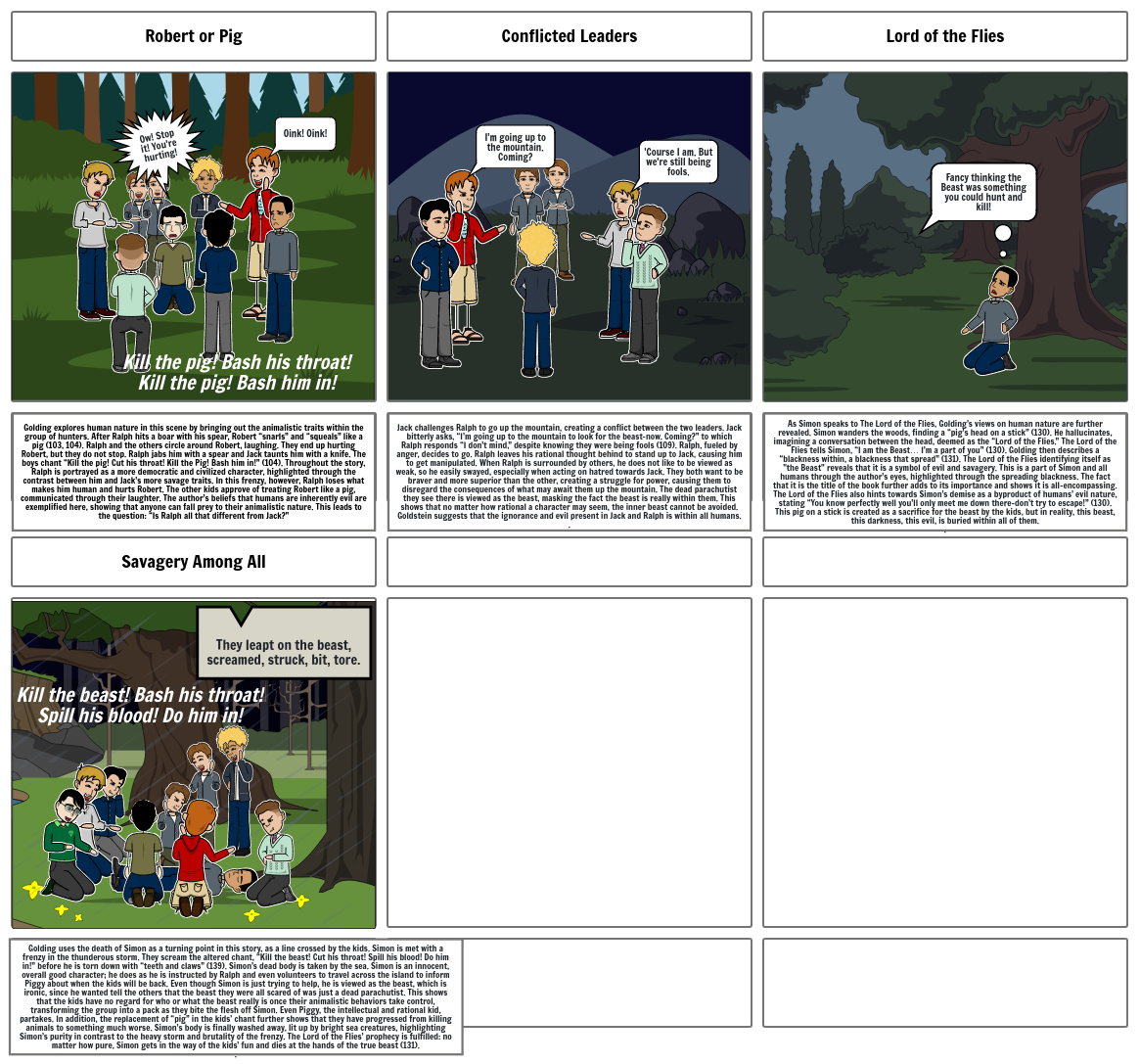Lord of the Flies

Storyboard Text
- Robert or Pig
- Kill the pig! Bash his throat!Kill the pig! Bash him in!
- Ow! Stop it! You're hurting!
- Oink! Oink!
- Conflicted Leaders
- I'm going up to the mountain. Coming?
- 'Course I am. But we're still being fools.
- Lord of the Flies
- Fancy thinking the Beast was something you could hunt and kill!
- Kill the beast! Bash his throat!Spill his blood! Do him in!
- Golding explores human nature in this scene by bringing out the animalistic traits within the group of hunters. After Ralph hits a boar with his spear, Robert “snarls” and “squeals” like a pig (103, 104). Ralph and the others circle around Robert, laughing. They end up hurting Robert, but they do not stop. Ralph jabs him with a spear and Jack taunts him with a knife. The boys chant “Kill the pig! Cut his throat! Kill the Pig! Bash him in!” (104). Throughout the story, Ralph is portrayed as a more democratic and civilized character, highlighted through the contrast between him and Jack’s more savage traits. In this frenzy, however, Ralph loses what makes him human and hurts Robert. The other kids approve of treating Robert like a pig, communicated through their laughter. The author’s beliefs that humans are inherently evil are exemplified here, showing that anyone can fall prey to their animalistic nature. This leads to the question: “Is Ralph all that different from Jack?”
- Savagery Among All
- They leapt on the beast, screamed, struck, bit, tore.
- Jack challenges Ralph to go up the mountain, creating a conflict between the two leaders. Jack bitterly asks, “I’m going up to the mountain to look for the beast-now. Coming?” to which Ralph responds “I don’t mind,” despite knowing they were being fools (109). Ralph, fueled by anger, decides to go. Ralph leaves his rational thought behind to stand up to Jack, causing him to get manipulated. When Ralph is surrounded by others, he does not like to be viewed as weak, so he easily swayed, especially when acting on hatred towards Jack. They both want to be braver and more superior than the other, creating a struggle for power, causing them to disregard the consequences of what may await them up the mountain. The dead parachutist they see there is viewed as the beast, masking the fact the beast is really within them. This shows that no matter how rational a character may seem, the inner beast cannot be avoided. Goldstein suggests that the ignorance and evil present in Jack and Ralph is within all humans..
- As Simon speaks to The Lord of the Flies, Golding’s views on human nature are further revealed. Simon wanders the woods, finding a “pig’s head on a stick” (130). He hallucinates, imagining a conversation between the head, deemed as the “Lord of the Flies.” The Lord of the Flies tells Simon, “I am the Beast… I’m a part of you” (130). Golding then describes a “blackness within, a blackness that spread” (131). The Lord of the Flies identifying itself as "the Beast" reveals that it is a symbol of evil and savagery. This is a part of Simon and all humans through the author’s eyes, highlighted through the spreading blackness. The fact that it is the title of the book further adds to its importance and shows it is all-encompassing. The Lord of the Flies also hints towards Simon’s demise as a byproduct of humans’ evil nature, stating “You know perfectly well you’ll only meet me down there-don’t try to escape!” (130). This pig on a stick is created as a sacrifice for the beast by the kids, but in reality, this beast, this darkness, this evil, is buried within all of them..
- Golding uses the death of Simon as a turning point in this story, as a line crossed by the kids. Simon is met with a frenzy in the thunderous storm. They scream the altered chant, “Kill the beast! Cut his throat! Spill his blood! Do him in!” before he is torn down with “teeth and claws” (139). Simon’s dead body is taken by the sea. Simon is an innocent, overall good character; he does as he is instructed by Ralph and even volunteers to travel across the island to inform Piggy about when the kids will be back. Even though Simon is just trying to help, he is viewed as the beast, which is ironic, since he wanted tell the others that the beast they were all scared of was just a dead parachutist. This shows that the kids have no regard for who or what the beast really is once their animalistic behaviors take control, transforming the group into a pack as they bite the flesh off Simon. Even Piggy, the intellectual and rational kid, partakes. In addition, the replacement of “pig” in the kids' chant further shows that they have progressed from killing animals to something much worse. Simon’s body is finally washed away, lit up by bright sea creatures, highlighting Simon’s purity in contrast to the heavy storm and brutality of the frenzy. The Lord of the Flies’ prophecy is fulfilled: no matter how pure, Simon gets in the way of the kids’ fun and dies at the hands of the true beast (131)..
Over 30 Million Storyboards Created

